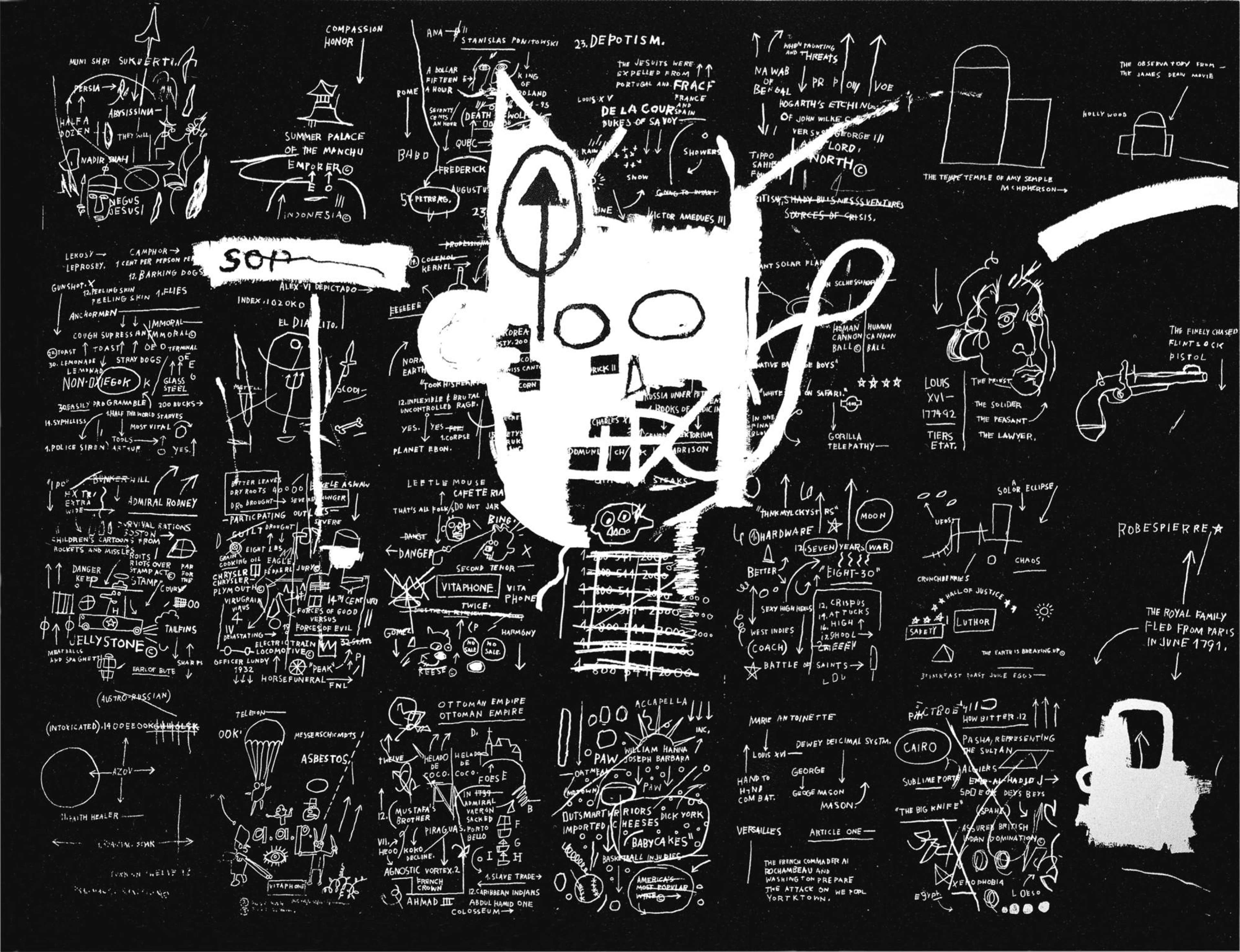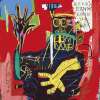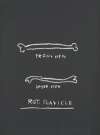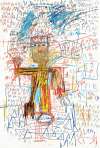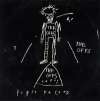A Seller’s Guide To Jean-Michel Basquiat


Interested in buying or selling
Jean-Michel Basquiat?
Market Reports
Jean-Michel Basquiat remains one of the most influential artists in the contemporary market, with strong institutional visibility, consistent global demand, and sustained interest across both originals and prints. His print market has become a dynamic category of its own, with both signed lifetime editions and estate-authorised releases seeing competitive bidding in 2025. If you’re considering selling a Basquiat print, this guide reflects the most current market data and provides clear steps to maximise your result.
Is Now A Good Time To Sell My Jean-Michel Basquiat Print?
Basquiat’s print market has strengthened meaningfully through 2025, following signs of a reset in late 2024. This year’s auction cycles – April, June, and now October 2025 – show consistent demand across both lifetime prints and estate editions.
New October 2025 Auction Results
The October sales delivered a strong set of mid-tier print results across Christie’s and Phillips, signalling continued appetite in the £40,000–£100,000 range (prices are inclusive of fees):
- Cabeza, Christie’s – $95,250
- Charles The First, Christie’s – $63,500
- Flexible, Christie’s – $76,200
- Rome Pays Off, Phillips – $61,920
- Posterior View (from Anatomy), Phillips – $42,570
Across the year, the strongest results have come from:
- The Daros Suite, achieving a record £134,495 at Sotheby’s.
- The Superhero Portfolio, sold for £143,824 at Phillips.
- The complete Rinso Suite, reaching £304,567 – a new benchmark for the series.
- An Artist Proof of Cabeza, achieving $194,191 at SBI Art Auction in Japan – reinforcing the premium placed on rare APs.
Together with the October numbers, these results confirm a stable to upward trajectory in Basquiat’s print market in 2025, with strong liquidity, solid mid-estimate performance, and notable depth across multiple print categories.
Basquiat’s Top Auction Results of 2025
Basquiat’s original works in 2025 show a continuation of exceptional outliers through rare works that still command high prices, though with more selectivity at the top.
Top 2025 Results:
- Crowns (Pesto Neto) – $48.3 million, Sotheby’s, November 2025
- Baby Boom – $23.4 million, Christie’s, May 2025
- Red Man One _ $22 million, Gaston & Sheehan Auctioneers, September 2025
- Untitled (1981) – $16.3 million, Sotheby’s, May 2025
- Sabado Por La Noche (Saturday Night) – $14.4 million, Christie’s Hong Kong, March 2025
While 2025 delivered one major highlight in Crowns (Pesto Neto) at $48.3 million, the defining trend of the year has been the consistency and depth within the $15–25 million range. Baby Boom, Red Man One, and Untitled each achieved strong results, anchoring their respective sales and demonstrating that demand for high-quality works remains resilient – even if buyers are more discerning about trophy-priced lots.
In a recalibrating market, sellers of ultra-high-value Basquiat works have become more selective about bringing pieces to auction. This has resulted in fewer blockbuster consignments, especially above $40 million and an increased focus from buyers on works priced between $15–25 million.
What the October 2025 Results Signal for Print Sellers
The October 2025 auctions offered several clear trends on the state of Basquiat’s print market. First, results for key editions such as Flexible and Cabeza demonstrated that demand for Basquiat’s most recognisable imagery remains robust, with competitive bidding across both Christie’s and Phillips.
The month also affirmed the enduring appeal of the Anatomy series, the only editioned print series produced during Basquiat’s lifetime. Posterior View achieving $42,570 at Phillips sits comfortably within the typical £30,000–£50,000 range, underscoring why these works remains some of the most liquid and consistently traded segments of the market for well-preserved editions.
Lastly, estate editions showed similar strength. Works such as Flexible and Rome Pays Off delivered solid mid-estimate performances, reinforcing the steady demand for authorised posthumous prints in the £40,000–£100,000 bracket. These sales demonstrate that, even without the signature premium attached to lifetime works, buyers remain confident in the quality and provenance of estate-produced editions.
How much Will My Jean-Michel Basquiat Print Sell For?
Top Tier: The Black-Ground 1983 Screenprints
Untitled (1983) (ed. 10 + 2 APs): record >£3m (2022)
Back of the Neck (1983) (ed. 24): reached £922,408 (2023), current value ~£700,000–£1m
High-value spikes in Basquiat print indices are still driven by the rare appearance of these editions.
Mid-Tier: Signed Prints & West Coast Editions
Outside the black 1983 editions, there are several other signed works that are equally rare to market. At Phillips in April 2024, five signed screenprints from an edition of 45 sold for £142,997 - more than double their high estimate. These prints, produced during Basquiat’s formative West Coast period with New City Editions, came from the personal collection of former NBA player and artist Desmond Mason.
There are also other editioned canvas works that appear occasionally - most recently Untitled (from Tuxedo), a signed screenprint on canvas, which sold for $342,900 (USD) at Phillips, far surpassing its $20,000–30,000 estimate. Its black-ground composition echoes the visual language of Basquiat’s most prized prints, reinforcing the strength of demand across both formats.
Anatomy Series
The Anatomy collection is is the only print series Basquiat produced during his lifetime - and it remains one of the most desirable and relatively accessible. Single prints sell for £30,000+, with partial sets of three or four achieving £40,000–£50,000. A full set hasn’t surfaced publicly since 2017, when it sold for £282,240 at Sotheby’s.
Estate Editions
Posthumous, estate-authorised editions have performed strongly, typically trading between £30,000 and £100,000. While not hand-signed, demand is sustained. The most recent release, Odours Of Punt (2024), appeared on the public market for the first time in 2025 selling for £79,517.
Authentication And Your Jean-Michel Basquiat Print
Provenance is critical when selling a Basquiat - especially since the Estate stopped authenticating works in 2012. Without a catalogue raisonné or formal archive, buyers and advisors rely heavily on documentation: gallery invoices, exhibition history, publication records, and past sales from recognised sources.
For original prints, identifying the publisher is a key step in verifying authenticity. The Anatomy series, for example, was published by Annina Nosei Gallery. Other early editioned works were produced by New City Editions in Venice, California, where Basquiat worked during his time on the West Coast. Lifetime prints tied to these publishers - and supported by signature and exhibition history - tend to carry more weight in the market.
For posthumous prints, authenticity hinges on correct attribution and publishing records. Since 2005, only Flatiron Editions and Pace Prints have released estate-authorised editions. Flatiron produced Hollywood Africans in Front of the Chinese Theater with Footprints of Movie Stars (2015), and in 2024, released Odours of Punt, based on a 1983 painting. Each edition varies in size and is released without regular schedule, making verification essential. Following the death of Gerard Basquiat in 2009, posthumous works are now signed by Basquiat’s aunts, Lisane Basquiat and Jeanine Heriveaux, who currently manage the estate.
Basquiat Catalogue Raisonné
Collectors also refer to Enrico Navarra’s catalogue raisonné-style survey, published in 1996 and updated in 2000. While unofficial, it remains one of the most widely used resources for verifying artworks and understanding Basquiat’s edition output.
Basquiat Collectors and Dealers
Influential collectors and dealers such as Yusaku Maezawa, Ernst Beyeler, and Jeffrey Deitch have also played a key role in building provenance around Basquiat’s market. Their involvement in private sales and institutional exhibitions - including Moderna Paintings and Valentine (1983–84) at Art Basel - adds credibility and traceability to artworks connected with their networks.
Forgeries In Basquiat's Market
Given Basquiat’s prominence, forgeries are a known risk, particularly in the prints market. Unauthorised editions and falsely attributed works do circulate, making it essential to trace provenance back to reputable galleries, publishers, or collectors. Verified documentation not only supports authenticity - it directly impacts buyer confidence and sale value.
What If My Jean-Michel Basquiat Print Needs Restoring?
Most of Basquiat’s prints were produced on high-quality archival paper - but condition plays a major role in determining value. His Anatomy series, created when he was just 22, was printed on Arches wove: a heavyweight, acid-free stock known for its durability. Still, these works are now decades old, and signs of wear - from paper tone to light exposure - can impact price and buyer confidence.
Some collectors and conservators have noted smudges or faint fingerprints on these works, likely from the production process. While there’s no way to confirm whose they are, these subtle traces speak to the hands-on nature of the screenprinting process at the time - part of what makes these prints so historically and materially interesting.
Estate-authorised prints are typically produced on Saunders Waterford, a premium paper stock used in contemporary printmaking. Though newer, these editions can also be vulnerable to poor framing or environmental damage if not properly cared for.
Whether you’re holding a lifetime print or a posthumous edition, professional framing and careful storage are essential. Small condition flaws can mean the difference between strong interest and a reduced offer. To hear directly from professional conservators about how to protect and preserve Basquiat prints, watch our OPEN EDITION Live Panel: Preserving Value.
Our team can also advise on restoration and long-term care - or visit The Directory for a list of trusted professionals for all your print preservation needs.
Ways to Sell with MyArtBroker
At MyArtBroker, our specialists offer free market valuations backed by transparent data. Using our online Trading Floor, you can access real-time insights into current demand for Basquiat prints - including works wanted, for sale, or trending - helping sellers make informed decisions with confidence.
Our MyPortfolio collection management tool offers free access to a comprehensive print market database. You can track auction history, hammer prices, sale returns, and historical values for your exact edition. In today’s fluctuating market, this level of visibility - typically paywalled elsewhere - is essential for accurate pricing and timing. Combined with our expert guidance, sellers benefit from both data and tailored advice.
Our approach is tailored to align with the unique attributes of each artwork, and offer optimal results:
How a Private Sale Works
Unlike peer-to-peer platforms, we manage private sales end-to-end - including authentication checks, legal safeguards, insurance, shipping, and marketing - all at no cost to the seller. We charge 0% seller commission, taking a small, negotiated fee from the buyer side. With lower overheads than traditional models, we’re able to deliver more value back to our clients.
We focus on artworks valued above £10,000, ensuring each sale receives specialist attention and market reach. For works below this threshold, we still offer free advice and can recommend trusted alternatives where needed.
Advisory and Recommendations
If your artwork isn’t best matched to our network - whether due to medium, condition, or value - we can advise on next steps and connect you with trusted partners. These recommendations are made case-by-case and reflect where your work is most likely to achieve the best result.
Our advisory service is free, and always tailored to the specifics of your Basquiat print.
Why Sale Your Jean-Michel Basquiat Print With MyArtBroker?
A Personalised Experience with Dedicated Experts
Selling your Basquiat print with MyArtBroker comes with tailored support at every stage. Our platform is built to offer a personalised experience, guiding you through the process with clarity and confidence. Our team provides free, no-obligation valuations, giving you an accurate read on market value based on current demand and past performance. With specialist knowledge of both Basquiat’s market and the wider prints landscape, we deliver clear, data-informed advice.
Minimising Risk
We prioritise transparency and security in every transaction. Our live Trading Floor provides up-to-date market data, helping you understand current trends and value benchmarks. We conduct thorough checks on provenance and authenticity, and where needed, work with trusted partners to verify key details - reducing the risks that can come with high-value sales.
By operating through private sales rather than public auctions, we help sellers avoid the reputational risk of unsold lots and offer faster liquidity outside of fixed auction calendars.
Zero Seller Fees
Unlike traditional auction houses or dealers, we charge no fees to the seller. Our revenue comes from the buyer side, allowing you to retain the full value of your sale. We specialise in rare and editioned prints, offering targeted marketing, direct buyer matching, and access to our in-house magazine and digital channels - all at no extra cost.
Access to a Vast Network
With over 30,000 collectors actively engaged on our platform, we can quickly connect your Basquiat print to serious, qualified buyers. This reach not only improves speed of sale, but increases your chances of securing a strong, competitive offer.
Jean-Michel Basquiat Collection Management With MyPortfolio
Utilise MyPortfolio for Jean-Michel Basquiat Collection Management
MyArtBroker’s MyPortfolio tool helps collectors manage, monitor, and assess their Basquiat prints and editions using real-time market data. Powered by our proprietary algorithm SingularityX, it draws from over 50,000 auction results and private sales to deliver dynamic, accurate valuations - factoring in condition, colourway, edition type, and other key attributes that shape value.
As financial quant Stuart Jamieson outlines in our specialist interview, these algorithmic tools are part of a broader shift in the art market - one where transparency, comparability, and performance tracking are increasingly central to collecting behaviour. In a market that’s evolving rapidly, data is no longer optional - it’s infrastructure.
Advanced Art Technology for Smart Collecting
Today’s collectors expect the same level of information and agility found in financial markets. As noted in our May 2025 Market Editor Report, this shift is already reshaping how artworks are bought, sold, and valued - particularly in the prints and editions market, where liquidity, recognisability, and pricing data drive demand.
MyPortfolio puts these tools directly in the hands of sellers - streamlining collection management, monitoring market momentum, and identifying optimal selling windows. Whether you’re reviewing historical sales, pricing trends, or liquidity signals, this is a smarter, data-led approach to navigating the Basquiat market in real time.
